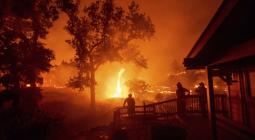The Guardian view on Texas storms and power cuts: preparing for the worst.

The outages endured by residents result from the state’s political decisions – but all of us need to think more about ensuring resilience.
Though the desperate conditions that millions of Texans have suffered for days were triggered by a powerful winter storm, the underlying issues are the work of human beings. At least 2.7 million households were still without power on Wednesday, and nearly 12 million faced water quality issues. Hospitals ran out of water. Families have burned belongings to keep their children warm.
As bizarre as it may seem that residents of the biggest energy-producing state in the US can be left powerless for so long, these problems were foreseen. While Republican leaders in Texas have blamed a reliance on renewable energy, it was mostly natural gas plants that failed, with a reactor at a nuclear facility also forced offline. The desire to stay free from federal oversight means that Texas has a stand-alone grid, preventing it from importing power. The lack of regulation meant that price competition took precedence over stability of service. The grid’s operator was warned following power outages 10 years ago that equipment needed to be protected against extreme low temperatures, but failed to act. The system prioritised profits instead of the people it was supposed to serve.
It remains astonishing that the richest country in the world cannot guarantee its residents such basic services such as reliable power, clean water and decent sanitation. But there should be no complacency elsewhere. Whether or not the heating of the Arctic is to blame for these particular snowstorms, as some scientists believe – by pushing frigid air from the north pole much further south – global heating means an increase in extreme weather events. Last year alone saw a Siberian heatwave, wildfires in Australia and the US, a record-breaking Atlantic hurricane season and storms and floods in many parts of Asia.
The UN warned last month that governments are failing to take the measures needed to adapt to climate breakdown. While many have recognised the threat, few have made adequate plans and fewer still have found the funding needed. People in developing countries will bear the brunt of the climate emergency. But those in wealthier nations are not immune.
Nor is climate change the only threat. The pandemic has underscored the vulnerability of what we previously considered normal life. Earlier this month, a hacker broke into the computer system of a Florida water treatment plant and attempted what could have amounted to a mass poisoning but for an attentive official. And as Sir John Armitt, chairman of the UK’s National Infrastructure Commission (NIC), warned following a widespread power outage in August 2019, many other elements of infrastructure – from the water supply to massive data systems to transport – are now reliant on electricity.
While the UK has one of the most reliable supplies in the world, proper preparation is required as it transitions to a decarbonised supply. Last year’s report on resilience by the NIC warned that we need a new framework for infrastructure that stresses the importance of being able to cope with crises, tests for vulnerabilities regularly and drives adaptation before it is too late. That means a strong role for the government and regulators in setting and maintaining standards. Consumers cannot often choose different levels of resilience, and infrastructure failures do not just affect consumers. “Resilience is not properly valued in the market,” it concluded – as Texans could now testify.
18 February 2021
The Guardian




